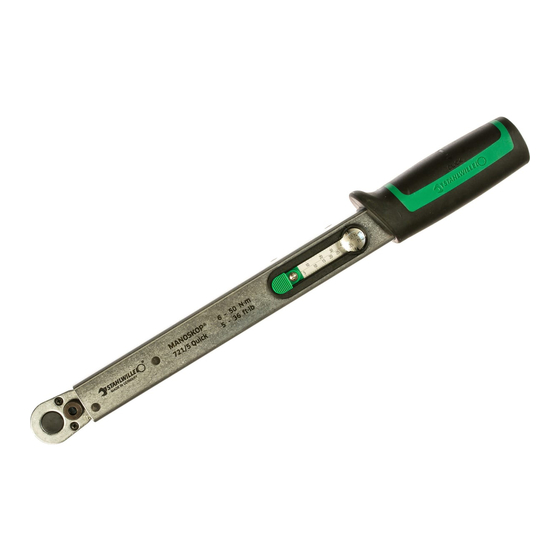Advertisement
STAHLWILLE
Standard Manoskop
721
Service Manoskop
730
List of contents
Technical description .................. 27
ã=Important safety points........... 30
Operation .................................... 32
Maintenance ............................... 42
Accessories ................................ 48
Disposal ...................................... 48
Technical description
All models
Manoskop
torque wrenches with a cut-out, tactile
and audible cut-out signals.
These torque wrenches have a safety
•
cut-out mechanism.
The wrench is set to cut-out at a
•
certain torque level by setting the
required value on the force-free
sliding scale.
The setting slide has an automatic
•
setting fail-safe mechanism.
The measuring element is a flexible
•
rod. The flexible rod is not
pretensioned so it is only under
tension from the start to the end of the
actual tightening operation until the
wrench cuts out.
®
721, 730 are adjustable
®
®
®
........... 47
27
Advertisement

Summarization of Contents
Product Technical Specifications
General Model Overview
General description of Manoskop® 721 and 730 torque wrenches, covering cut-out signals and mechanism.
Manoskop 721/5 & 721/15 Details
Details on Manoskop® 721/5 and 721/15 models, highlighting switchable ratchet and square drive.
Manoskop 721/30 Details
Details on Standard Manoskop® 721/30 model, noting its switchable ratchet and square drive.
Manoskop 730/2 to 730/65 Details
Information on Manoskop® 730/2 to 730/65 models, including insert tool compatibility and rotation.
Critical Safety Guidelines
Defined Usage Scope
Defines the proper and intended use of Manoskop® 721 and 730 torque wrenches in workshop environments.
Ensuring Accurate Torque Settings
Guidance on achieving correct torque settings and the importance of regular checks for accurate cut-out.
Application-Specific Safety Notes
Highlights that other safety points may apply based on specific applications, marked with danger symbols.
Operating the Torque Wrench
Selecting Proper Inserts and Tools
Instructions on choosing and using the correct inserts and insert tools with STAHLWILLE torque wrenches.
Attaching Inserts to 721 Series
Step-by-step guide for attaching insert tools to Manoskop® 721/5 and 721/15 models.
Attaching Inserts to 730 Series
Instructions for attaching insert tools to Manoskop® 730/2 to 730/65 models.
Removing Insert Tools Safely
Procedure for safely removing insert tools from 730/2 and 730/4 torque wrenches.
Torque Setting Procedures
Counter-Clockwise Tightening Method
Explanation of how to perform controlled counter clockwise tightening with specific Manoskop® models.
Uncontrolled Loosening Procedure
Guidance on performing uncontrolled loosening of nuts and bolts with the torque wrench, with safety precautions.
Safe Torque Wrench Application
Essential checks and safe application methods for using the torque wrench effectively and preventing damage.
Tool Maintenance and Calibration
Verifying Cut-out Accuracy
Procedure for verifying the accuracy of the torque wrench's cut-out mechanism using a torque tester.
Correcting Torque Deviations
Instructions for readjusting the torque wrench if deviations in the cut-out value are detected.
Manoskop Cleaning Instructions
Recommended cleaning methods and cleaning agents for Manoskop® torque wrenches.
Available Accessories and Services
Compatible Insert Tools
Details on various insert tools compatible with STAHLWILLE Service Manoskop® 730.
Calibration and Testing Equipment
Information on torque testers used for inspection and readjustment of Manoskop® torque wrenches.
STAHLWILLE Support Services
Overview of services offered by STAHLWILLE, including repairs and recalibration.
Product Disposal Recommendations
Guidelines for the proper disposal of Manoskop® torque wrenches according to environmental regulations.















Need help?
Do you have a question about the Manoskop 730 and is the answer not in the manual?
Questions and answers